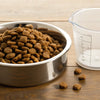How Much Rice for Dog by Weight (kg): The Ultimate Guide for Pet Owners
- Houndsy
Table of Contents
- Introduction
- Understanding the Nutritional Benefits of Rice for Dogs
- How Much Rice to Feed Your Dog Based on Weight
- Preparing and Serving Rice to Your Dog
- Considerations and Potential Risks
- Alternatives to Rice
- Conclusion
- Frequently Asked Questions (FAQs)
Introduction
As pet owners, we always want the best for our furry friends, especially when it comes to their nutrition. Did you know that rice is one of the most commonly recommended foods for dogs recovering from digestive issues? This versatile grain is not only easy to digest but also provides essential carbohydrates. However, a burning question many of us have is: how much rice should we actually feed our dogs based on their weight?
In this blog post, we will explore the nutritional benefits of rice for dogs, understand the appropriate portion sizes based on weight, and discuss how to integrate rice into your dog's diet safely. By the end of this guide, you will have a clear understanding of how to make rice a beneficial part of your dog's meals without compromising their health. So, let’s dive in and reflect on our own pet feeding routines!
What You Will Learn
We aim to provide you with actionable insights into feeding rice to your dog by discussing:
- The nutritional benefits of rice for dogs.
- How to determine the right portion size based on your dog's weight.
- Best practices for preparing and serving rice.
- Considerations for integrating rice into your dog's overall diet.
- Alternatives to rice and when to consult with a veterinarian.
Let’s get started on this journey to elevate the feeding experience for our beloved pets!
Understanding the Nutritional Benefits of Rice for Dogs
Rice is a staple food for many cultures around the world, and it also holds several benefits for our canine companions. Here’s a closer look at why rice can be a good addition to your dog’s diet:
1. Easy Digestibility
Rice, especially white rice, is easy on a dog’s stomach. This makes it an excellent choice for dogs recovering from gastrointestinal upset or diarrhea. The blandness of rice helps soothe the digestive tract, allowing it to rest and recover without irritation.
2. Source of Energy
Carbohydrates are vital for energy, and rice is a great source. For active dogs, providing the right amount of energy is crucial to their overall health and performance. Incorporating rice into their meals can help fuel their daily activities.
3. Gluten-Free Option
Many dogs suffer from gluten sensitivities or allergies. Rice is naturally gluten-free, making it a safe alternative to other carbohydrate sources that may cause digestive issues.
4. Nutrient-Rich
While rice is primarily a carbohydrate source, it also contains essential vitamins and minerals, such as B vitamins, iron, and magnesium. These nutrients support various bodily functions, including metabolism and immune health.
5. Cost-Effective
Rice is an affordable ingredient, making it accessible for pet owners who want to provide quality nutrition without breaking the bank.
How Much Rice to Feed Your Dog Based on Weight
When it comes to feeding rice to your dog, portion control is essential. Overfeeding can lead to obesity and other health issues. The general guideline for feeding rice is to provide about 2% to 3% of your dog’s body weight per day in total food.
Portion Size Guide
Here's a practical breakdown of how much rice you should feed your dog based on their weight:
- Small Dogs (1-10 kg): About 50-150 grams of rice per day.
- Medium Dogs (11-25 kg): About 150-300 grams of rice per day.
- Large Dogs (26-40 kg): About 300-450 grams of rice per day.
- Extra Large Dogs (41 kg and above): About 450-600 grams of rice per day.
To provide a more tailored approach, consider the weight of your dog. For example, a 10 kg dog would require approximately 100 grams of cooked rice mixed with their regular food. Always remember to adjust portions based on your dog's activity level and overall health.
Calculating Rice by Weight
To determine the exact amount of rice to feed your dog, it’s best to use a simple formula. Here’s how it works:
- Weigh Your Dog: Know your dog’s current weight in kilograms.
- Use the Portion Size Guide: Refer to the above chart to find the appropriate daily rice amount.
- Prepare the Rice: Ensure you cook plain white rice without any additives, such as salt or spices.
Preparing and Serving Rice to Your Dog
The preparation of rice is relatively straightforward, but there are some best practices to keep in mind to ensure it’s safe and nutritious for your dog.
Cooking Rice
- Rinse the Rice: Before cooking, rinse the rice under cold water to remove excess starch.
- Boil with Water: Use a ratio of 1 cup of rice to 2 cups of water. Bring the water to a boil, then add the rinsed rice.
- Simmer: Reduce the heat to low, cover, and let it simmer until the rice is fully cooked and has absorbed the water (about 15-20 minutes).
- Cool Down: Allow the rice to cool before serving it to your dog. Hot food can cause burns.
Mixing Rice with Other Foods
While rice can be a great addition to your dog's diet, it's essential to mix it with other nutritious ingredients to ensure a balanced meal. Consider combining rice with:
- Lean meats (like chicken or turkey)
- Vegetables (like carrots or peas)
- Dog-safe broth for added flavor
A good rule of thumb is to aim for a 2:1 ratio of rice to protein (e.g., 2 cups of rice to 1 cup of chicken). This combination will provide a nutritious and satisfying meal for your dog.
Considerations and Potential Risks
While rice can be beneficial for many dogs, it’s important to consider potential risks and limitations.
1. Not a Complete Diet
Rice should not be the sole component of your dog's diet. While it offers carbohydrates, it lacks essential nutrients, such as certain vitamins and fatty acids. Always supplement rice with high-quality protein sources and other nutrients.
2. Allergies and Sensitivities
Some dogs may have allergies or sensitivities to rice. If you notice any adverse reactions, such as itching, gastrointestinal upset, or other symptoms, consult your veterinarian.
3. Limit Portion Sizes
As mentioned earlier, portion control is crucial. Feeding too much rice can lead to weight gain and other health issues. Always monitor your dog’s weight and adjust their diet accordingly.
Alternatives to Rice
If you’re looking for alternatives to rice or want to mix things up in your dog’s diet, consider these options:
- Quinoa: A protein-rich grain that is gluten-free and easy to digest.
- Oats: Oats can be beneficial for dogs and are often gentler on the stomach than rice.
- Sweet Potatoes: Rich in vitamins and fiber, sweet potatoes can be a great carbohydrate source.
Conclusion
Feeding your dog rice can be a beneficial part of their diet when done correctly. Not only does it provide a source of energy and nutrients, but it also supports their recovery from digestive issues. By understanding how much rice to feed your dog based on their weight and integrating it into a balanced diet, we can enhance our pet's feeding experience while ensuring their health and happiness.
As we explore ways to elevate our feeding rituals, consider the Houndsy Kibble Dispenser. Designed with convenience and style in mind, it allows for easy portion control and fits beautifully into modern home decor. Order Now and make the feeding experience even more enjoyable for you and your furry friend!
Frequently Asked Questions (FAQs)
1. Can all dogs eat rice?
Yes, most dogs can eat rice, particularly white rice, which is easy to digest. However, it's essential to consider any specific allergies or sensitivities your dog may have.
2. How long can I feed my dog rice?
Rice can be fed as part of a balanced diet or as a temporary solution for digestive issues. For long-term use, ensure it’s supplemented with other nutrients.
3. Can I use brown rice instead of white rice?
Brown rice is more nutritious but can be harder for some dogs to digest, especially those with sensitive stomachs. White rice is generally recommended for digestive issues.
4. Is it okay to add vegetables to the rice meal?
Yes! Adding dog-safe vegetables can enhance the nutritional value of the meal. Carrots, peas, and green beans are good options.
5. How do I transition my dog back to regular food after a rice diet?
Gradually mix the regular food with rice over several days, reducing the amount of rice incrementally while increasing the regular food until your dog is back to their normal diet.
By being informed and attentive to our dogs' dietary needs, we can ensure they live happy, healthy lives. Let's embrace the journey of pet ownership with love, care, and the right nutrition!












